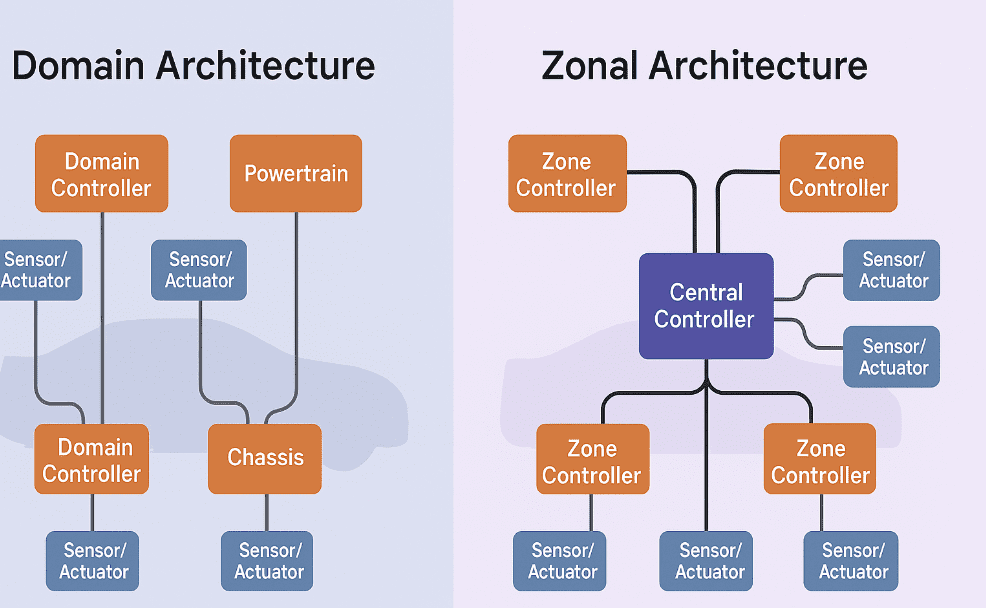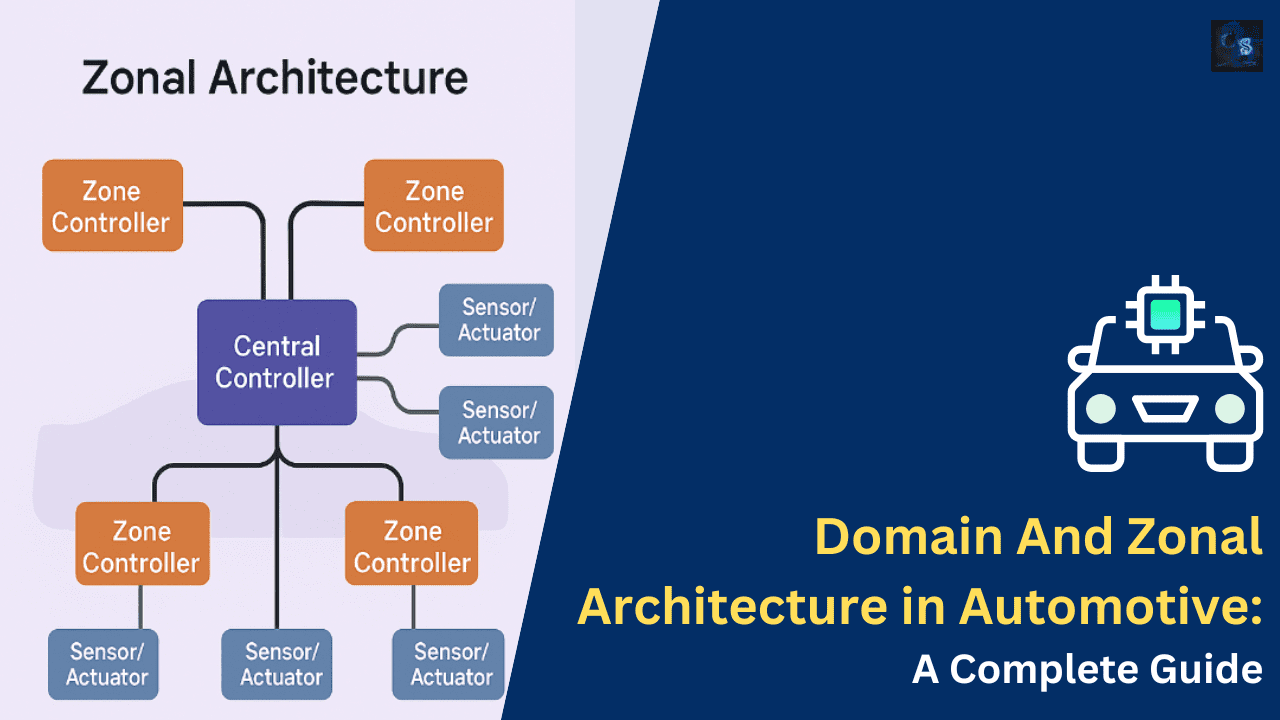Difference Between Domain And Zonal Architecture in Automotive: A Complete Guide
Hello guys, welcome back to our blog. In this article, I will discuss domain and zonal architecture in Automotive, its key differences, and why the shift towards the zonal architecture.
Ask questions if you have any electrical, electronics, or computer science doubts. You can also catch me on Instagram – CS Electrical & Electronics
- Roadmap To Become A Successful Hardware-in-the-Loop (HiL) Engineer
- 1000+ Automotive Interview Questions With Answers
- RTOS In The Automotive Industry: The Brains Behind Real-Time Vehicle Control
Domain And Zonal Architecture in Automotive
The automotive industry is undergoing a paradigm shift as vehicles become more connected, intelligent, and autonomous. Central to this transformation is the vehicle’s electrical/electronic (E/E) architecture — the backbone that supports software-driven functionality and data communication. Historically, Domain Architecture was the standard, but now the industry is steadily transitioning toward Zonal Architecture.
This article explores the difference between Domain and Zonal Architecture in the automotive world, their design principles, benefits, challenges, and why the industry is moving toward zonal systems for future-ready vehicles.
What is Automotive E/E Architecture?
Automotive Electrical/Electronic (E/E) Architecture refers to the integrated system of electronic control units (ECUs), communication networks (such as CAN, LIN, FlexRay, and Ethernet), sensors, actuators, and software that manage and control vehicle functions — from basic operations like lighting and braking to advanced driver-assistance systems (ADAS) and infotainment.
As vehicles became more complex, E/E architecture evolved to accommodate more functionalities, giving rise to distinct approaches like Domain and Zonal Architectures.
What is Domain Architecture?
Definition: Domain architecture refers to the logical grouping of ECUs based on functionality or application domains, such as powertrain, chassis, body, infotainment, and ADAS.
Structure: Each domain contains several ECUs responsible for managing specific systems. For instance:
- Powertrain Domain: Engine control, transmission
- Chassis Domain: Braking, suspension
- Body Domain: Lighting, doors, HVAC
- Infotainment Domain: Audio, navigation
- ADAS Domain: Cameras, radar, driver assistance functions
Each domain has a domain controller, and communication often involves cross-domain data exchange via gateways.
Advantages:
- Functional modularity and clarity
- Easier development of software stacks within domains
- Good for medium-complexity vehicles
Limitations:
- Increased wiring complexity as sensors and actuators are distributed across the vehicle
- Redundant hardware and communication paths
- Difficult to scale for high-data applications (like autonomy)
- Cross-domain communication requires complex gateways
What is Zonal Architecture?
Definition: Zonal architecture organizes the vehicle’s ECUs based on physical location (zones) rather than function. Each zone — front left, front right, rear, center — contains a Zonal Control Unit (ZCU) that aggregates signals from sensors and actuators in its area.
Structure: The vehicle is divided into geographic zones.
- Each zone collects sensor/actuator data and performs pre-processing locally.
- Zonal controllers communicate with a central vehicle computer or a high-performance compute platform.
- The communication backbone is typically automotive Ethernet.
Advantages:
- Significant reduction in wiring harness length and weight
- Scalable and modular design
- Simplified maintenance and diagnostics
- Better suited for high-speed data processing (e.g., for autonomous driving)
- Enables centralized software-based control
- Lower manufacturing cost on a large scale
Limitations:
- High reliance on software and centralized processing
- Requires robust zonal controllers with higher computational power
- Migration from the domain to the zonal requires a complete E/E redesign
Domain Vs Zonal Architecture: Key Differences
| Aspect | Domain Architecture | Zonal Architecture |
| Organization | Function-based (domains) | Location-based (zones) |
| ECU Distribution | Many function-specific ECUs | Fewer, multi-functional ZCUs |
| Wiring | Long and complex | Shorter, optimized |
| Communication | Gateway-heavy, CAN/LIN | Central backbone, mostly Ethernet |
| Processing | Distributed across domains | Centralized compute platform |
| Scalability | Limited | Highly scalable |
| Software Integration | Moderate complexity | High, with potential for SOA |
| Maintenance | Complex diagnostics | Easier zonal diagnostics |
| Cost (long term) | Higher due to redundancy | Lower due to optimization |
| Future readiness (ADAS/EV) | Limited | Highly compatible |

Why the Shift Towards Zonal Architecture?
Several factors are driving the move from domain to zonal architecture:
A. Software-Defined Vehicles (SDVs):
Modern vehicles are defined more by software than hardware. Zonal architecture provides a platform to update, deploy, and manage software across the vehicle seamlessly.
B. Electrification and Autonomy:
Electric vehicles (EVs) and autonomous vehicles require high-speed communication, centralized computing, and reduced weight — all supported more effectively by zonal systems.
C. Wiring Harness Optimization:
Wiring is one of the heaviest and costliest components in a car. Zonal architecture reduces the length and complexity of wiring by localizing sensor integration.
D. Scalability and Modularity:
Zonal systems allow OEMs to reuse zones across different vehicle models and platforms, reducing development effort and cost.
Example Use Cases
Domain Architecture:
- Most vehicles until 2020, including ICE vehicles with basic ADAS
- BMW 5 Series (G30), Ford F-150 (pre-2020) used domain-based logic
Zonal Architecture:
- Tesla Model S Plaid uses a zonal setup with central compute units
- Volkswagen’s SSP Platform (Scalable Systems Platform) is zonal
- Mercedes-Benz MB.OS and BMW’s Neue Klasse architecture adopt zonal computing
- GM’s Ultifi platform for electric vehicles
Transition Strategies from Domain to Zonal
Shifting from domain to zonal isn’t immediate. OEMs follow transitional architectures such as:
A. Hybrid Architecture:
- Combines domain controllers with zonal gateways
- Used in vehicles during the shift (e.g., Audi e-tron, BMW iX)
B. Intermediate Platform Standardization:
- Replacing legacy ECUs with software-defined controllers
- Implementing an Ethernet backbone with existing domain systems
C. Central Compute Integration:
- Slowly offloading functions from domain ECUs to a central compute unit
- Using virtualization (hypervisors) to run multiple functions on shared hardware
The Role of Software and Service-Oriented Architecture (SOA)
Zonal architecture lays the groundwork for SOA-based vehicles, where functions are encapsulated as services that can be updated OTA (Over-The-Air), reused, or monetized.
For example: Adaptive cruise control, lane keep assist, and driver monitoring can all be microservices deployed to the central compute unit and accessed via the zonal network.
Security and Safety in Zonal Architecture
A. Cybersecurity:
- Requires zonal gateways to act as firewalls
- Encryption and authentication for Ethernet communication
- Centralized logging and anomaly detection
B. Functional Safety (ISO 26262):
- Local fail-operational capabilities in zonal units
- Redundant compute paths for safety-critical applications
Challenges in Zonal Architecture
Despite its benefits, zonal architecture introduces new challenges:
- Software complexity: More reliance on central software orchestration
- High integration cost upfront
- Increased need for skilled embedded/software engineers
- Thermal management for powerful zonal and central units
- Standardization issues across suppliers
Future Outlook
By 2030, over 80% of new vehicles are expected to adopt zonal architectures. Industry trends include:
- SOA platforms like VW’s VW.OS, MB.OS, Ultifi (GM), and SDV by Stellantis
- Hardware consolidation into domain-agnostic compute units
- AI integration in centralized units for autonomy
- OTA and vehicle cloud connectivity are becoming standard
Summary
| Feature | Domain Architecture | Zonal Architecture |
| Based On | Function | Physical Location |
| ECU Count | High | Reduced |
| Wiring | Long, complex | Shorter, simpler |
| Data Flow | Domain gateways | Ethernet backbone |
| Scalability | Limited | High |
| Suitable For | ICE, low-autonomy | EV, high-autonomy |
| Central Compute | Not essential | Essential |
Conclusion
As the automotive industry embraces electrification, autonomy, and software-defined paradigms, the transition from domain to zonal architecture becomes inevitable. Zonal systems not only address the complexity and scalability issues of modern vehicles but also provide a foundation for future innovations like AI, V2X, and autonomous driving.
OEMs, Tier 1 suppliers, and software vendors must adapt rapidly, rethinking vehicle design, software development, and integration practices to align with this evolution. Those who succeed in mastering zonal architecture will shape the next generation of mobility.
This was about “Domain And Zonal Architecture“. Thank you for reading.
Also, read:
- Difference Between Domain And Zonal Architecture in Automotive: A Complete Guide
- Roadmap To Become A Successful Hardware-in-the-Loop (HiL) Engineer
- 1000+ Automotive Interview Questions With Answers
- RTOS In The Automotive Industry: The Brains Behind Real-Time Vehicle Control
- High Performance Computers in Software-Defined Vehicles (SDVs): Architecture, Challenges, and Future Trends
- Automotive HPC Wars: The Race To Power Software-Defined Vehicles
- Why The Automotive Industry Is Down: No Automotive Jobs and When Will It Become Normal Again?
- Lane Departure Warning Systems: Your Guardian on the Road


